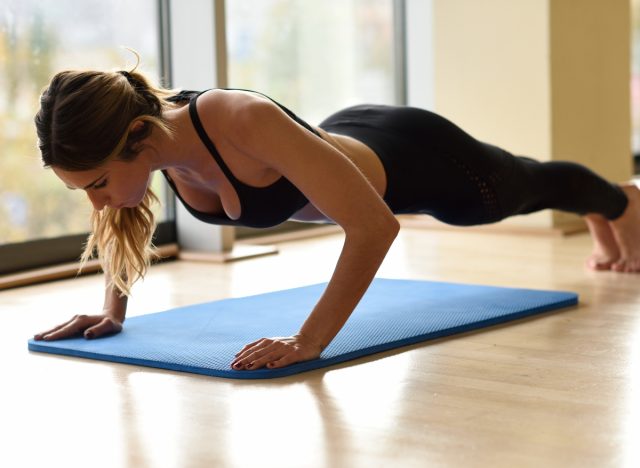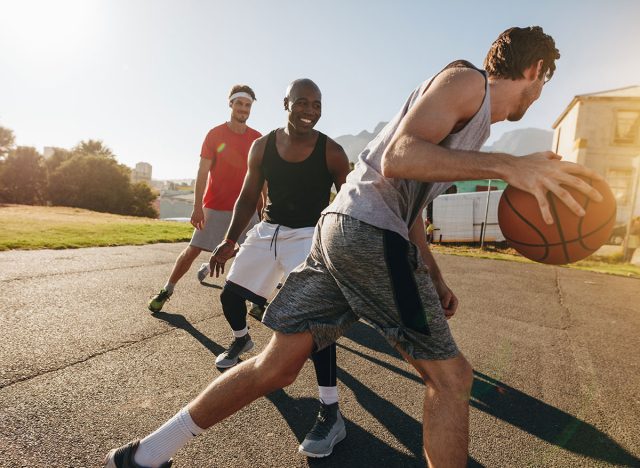8 Common Exercises That Destroy Your Body Faster Than Sitting After 40

Leading a sedentary life can absolutely wreck your body and overall health. In fact, research shows sedentary habits can increase all-cause mortality, cancer risk, CVD mortality, and chances of developing metabolic disorders. That said, there are certain exercises that can be just as harmful after you hit 40—and they should be avoided at all costs.
As you age, your workout routine should be tweaked according to your body’s current needs. For instance, high-impact activities may be more challenging for older athletes, as reaction time naturally decreases with age, says Dr. Milica McDowell, doctor of PT, exercise physiologist, and VP of operations at Gait Happens. In addition, movement coordination begins to become “less intuitive.”
“This isn’t to say an older athlete can’t enjoy activities like pickleball, basketball or plyometrics safely; it’s more that they need a longer warm up, more repetitions to get the ‘muscle memory’ back, and definitely should ramp up and practice these types of movements rather than just jumping into exercises they haven’t done since high school,” McDowell explains.
Especially after hitting 40, maximizing your attention to alignment is a must.
“In fact, some of the most common moves in the gym can actually speed up wear and tear on your body after 40 if not done right,” says Robert Brace, celebrity trainer and founder of Brace Life Studios. “Once you cross 40, your joints and connective tissue are also not as forgiving as they were in your twenties. Exercises that crank on your lower back, knees, and shoulders can accelerate damage if you don’t adapt them.”
Being sedentary should absolutely be avoided—and so should the below exercises.
8 Common Exercises That Destroy Your Body
Plyometric Exercises

Exercises like box jumps, plyo pushups, burpees, and lateral bounds can be incredibly harsh on your body as you age.
“Plyometric exercises in those who aren’t used to them can put your connective tissues (think Achilles tendon) at risk,” McDowell notes. “If you haven’t done a box step-up in years, progressing to activities like box jumps—or worse, jumping down from a box jump—can be super risky for lower body tendons.”
Twisting Exercises

Russian twists, cable woodchops, and landmine rotations are all examples of exercises that have a twisting component.
“Twisting exercises can be risky for those with limited mobility,” McDowell stresses. “If you have poor range of motion, doing exercises like woodchops or medicine ball cross body movements can irritate your low back.”
Rucking

Rucking involves wearing a weighted backpack—or rucksack—while walking or hiking. If you aren’t conditioned for this form of exercise, McDowell cautions to avoid it.
“Many people are trying weighted waking (rucking, or weighted vests) for the first time, and adding additional load can exacerbate old injuries if you haven’t properly ramped up by using small increments of weight over weeks or months,” she says.
Olympic Lifts

If you aren’t trained, Olympic lifts are another intense exercise to avoid.
“Picking up a barbell without expert instruction can be a recipe for injury,” McDowell explains. “Resist the peer pressure in workout classes like HIIT or CrossFit to try snatches, cleans or deadlifts if you haven’t had 1:1 coaching to properly learn the techniques.”
Sprinting Sports

While McDowell recognizes that this may be an unpopular opinion, if you’re 40+ and don’t regularly play a sport that requires sprinting—like basketball or soccer—the risks of a calf, hamstring, or groin injury far outweigh any benefits.
Sit-Ups And Crunches

If done improperly, sit-ups and crunches can overwork your hip flexors and spine while minimally engaging your deep core muscles.
“Few people take the time or have the know-how to do them the right way,” Brace tells us. “I’ve seen many people pulling on their necks to get up and going back down with a straight unprotected spine. This can lead to injury.”
Behind-The-neck Lat Pulldowns or Presses

Brace cautions against behind-the-neck presses or pulldowns.
“This one is not a favorite of mine. There are other, safer ways to get the same job done,” Brace stresses. “[The motion] puts your shoulders in an unnatural position that strains the rotator cuff and can [strain] or even hurt the neck.”
Long-Distance, High-Impact Running

While running can be a great cardio workout, beware of improper technique.
“In addition, the repetitive pounding breaks down joints more than it builds your body up,” Brace says.
Looking for easy ways to lose fat? Here’s How Long Your Walking Workout Should Be To Shrink Belly Fat.